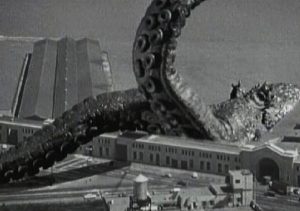By Paul Kieniewicz (SMN)
 A curious synchronicity hit me the other day. I had a lengthy discussion with my son in law about octopuses. According to a book he was recommending, octopuses have a highly specialized brain that has a totally different structure from the brains of vertebrates. This could be evidence that a central nervous system evolved twice on our planet, independently. And then I came across a new paper on panspermia, suggesting that the Cambrian explosion was caused by alien retroviruses, seeded on our planet by comets. As for octopuses, they might have originated as an alien life-form that landed on the Earth. The paper in question, Cause of Cambrian Explosion – Terrestrial or Cosmic? has 33 authors, and was published in a peer-reviewed journal, Progress in Biophysics and Molecular Biology. It’s fair to say that most biologists greeted the paper with derision, as its central thesis, that life began in interstellar space, then rained down on our Earth, or was brought by comets, runs counter to currently accepted ideas that life was first synthesized in the Earth’s oceans.
A curious synchronicity hit me the other day. I had a lengthy discussion with my son in law about octopuses. According to a book he was recommending, octopuses have a highly specialized brain that has a totally different structure from the brains of vertebrates. This could be evidence that a central nervous system evolved twice on our planet, independently. And then I came across a new paper on panspermia, suggesting that the Cambrian explosion was caused by alien retroviruses, seeded on our planet by comets. As for octopuses, they might have originated as an alien life-form that landed on the Earth. The paper in question, Cause of Cambrian Explosion – Terrestrial or Cosmic? has 33 authors, and was published in a peer-reviewed journal, Progress in Biophysics and Molecular Biology. It’s fair to say that most biologists greeted the paper with derision, as its central thesis, that life began in interstellar space, then rained down on our Earth, or was brought by comets, runs counter to currently accepted ideas that life was first synthesized in the Earth’s oceans.
Panspermia — the hypothesis that primitive life forms are prevalent in interstellar space, has a long history that goes back to ancient Greece. The eminent astrophysicist Fred Hoyle, along with his student (and co-author of the above paper) Chandra Wickramasinghe, developed a modern version since the 1960s. Both cited the low probability of synthesizing RNA and the first proteins on Earth, in the short time necessary. According to latest evidence that was less than 500m years after the Earth formed, when the first oceans appeared. Edward Steele, one of the paper’s authors said, “it is many orders of magnitude more likely that life emerged in one of the trillions of comet-like incubators or water-bearing planets at a very early time in the growth of this universe”.
However the above paper also questions whether natural selection is the dominant mechanism for evolution, and whether neo-Darwinism is the correct model for evolution. Edward Steele has for long championed a version of Lamarckian evolution, where viruses from outer space are integrated into our DNA through a process called Horizontal Gene Transfer. Evolution may proceed not by random mutations in DNA, but by incorporating material that continually rains down on our planet from interstellar space.
Is this wild idea right? In his day Fred Hoyle was known for some crazy ideas that were originally laughed at, only to eventually be proved right. In the late 1940s he proposed that interstellar dust clouds were teeming with organic molecules, possibly primitive life forms. Peer-reviewed journals rejected his paper. Current thinking was that molecular structures formed with great difficulty in interstellar space, and if they formed, they would certainly not be stable. Undeterred, Hoyle turned the basic idea into a science fiction novel, The Black Cloud, in which a dust cloud passes through the solar system and blocks out the sun. The cloud eventually turns out to be a sentient being. No sooner was the book published than radio astronomers began to discover the complex molecules that Hoyle had predicted — organic molecules, and then components of amino acids.
Life on Earth is beautiful, miraculous, and unlikely. All biologists to some extent admit this, but see no alternative explanation than that it somehow happened by chance. More skeptical, Hoyle wrote,
A junkyard contains all the bits and pieces of a Boeing 747, dismembered and in disarray. A whirlwind happens to blow through the yard. What is the chance that after its passage a fully assembled 747, ready to fly, will be found standing there? So small as to be negligible, even if a tornado were to blow through enough junkyards to fill the whole Universe.
So, if the origin of life is so unlikely, how did it happen in so short a time? Panspermia offers one answer, but it requires significant changes in the way we look at evolution.
